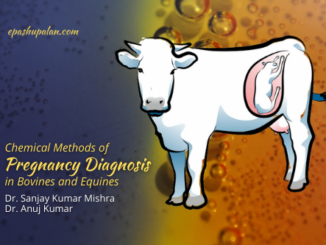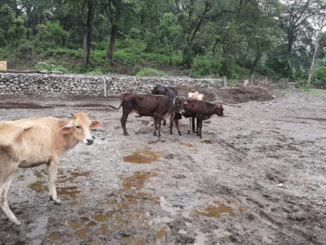Without reproduction there will be neither lactation nor replacements of herds for future. Therefore, the maintenance of a high fertility rate is basic to the success of any dairy farming enterprise and its viability is a business. For high lifetime production and overall return per cow, a long life and regular reproduction are essential. Careful attention to a number of details in management is the key word for efficient reproduction.
Important Reproduction Parameters
- Calving rate: The best evidence of fertility of a cow is a successful reproduction – a calf at foot. Therefore, the calving rate measures the number of cows calving out of total cows (%) during a specific period.
- Services per conception: A cow may need one or more services before she is settled. When the semen is of high fertility and cow is inseminated at proper time, the number of services required for conception gives a quantitative measure of fertility of the cow.
- Non- Return Rate: In AI programmes, a feed-back of information with respect to successful conception is very important for policy making such as needed to cull bulls of low fertility, modifications in semen handling and storage, improvement in insemination techniques etc. Therefore, we cannot wait until information on conception or calving rate is forthcoming. This measure is based on the assumption that if cow after an initial insemination is not brought again for another insemination within 60 to 90 days the cow is pregnant.
- Calving Intervals: The amount of time (days/months) between the birth of a calf and birth of subsequent calf, both from same cow. A calving interval of 12 months for cows and 13 months for first calf heifers has been found to be optimum. However, in higher producing cows of good persistency calving interval up to 15 months will not affect production.
- Breeding efficiency of individual cows can be calculated with the help of formulae given by Tomar (1967)
- For cows BE=[n(365)+1020]/(AC+CI)*100
- For buffaloes BE=[n(365)+1040]/(AC+CI)*100
Where
- BE= breeding efficiency
- n = number of calving intervals
- 365= desired calving interval in days
- 1020= desired age at first calving in days in cows
- 1040= desired age at first calving in days in buffaloes
- AC= actual age at first calving in days
- CI= Sum of actual calving intervals studied in days
Factors Involved in Reproduction Management of Cattle and Buffalo
- Observation and Record Keeping: Two aspects of good management that are generally neglected are regular and careful observation of the animals in the herd and keeping of production and reproduction records. Records help in keeping track of date of service, pregnancy checkup and calving date. Besides, records can be valuable not only to herdsman but also to veterinarian and others who can use them to trace trouble.
- Increasing Useful Life: Among adult cows, a calf per year per cow should be ultimate aim, though among tropics it can rarely be achieved. However it is not impossible to attain in cows. In buffaloes, intercalving period of 13-15 months must be the target with a service period of 2 to 21/2 month and dry period of same duration.
- Right Time of Insemination: Ovulation takes place about 12 hours after the end of estrus. It takes around 6 hours for ovum to travel half-way down the oviduct. The sperm must be exposed to the female reproductive tract for about 6 hours to attain the capacity to fertilize which is known as capacitation. Sperm are viable for around 24 hours in the female reproductive tract whereas the ovum remains fertile for only about 10 hours after ovulation. This implies that mating or insemination between mid-estrus (middle of standing heat followed by another insemination in about 6 hours after that. As a routine practice, if a cow is showing signs of early heat in the morning, it may be inseminated in the evening. If such signs are manifested in the evening, then the cow may be bred on next day morning. A cow is expected to show estrus in around 30-40 days after calving. If cow fails to show heat even after 50 days have generally some problem and need examination. It may be due to infection or malnutrition and remedial measures may be taken accordingly.
- Silent Heat: It occurs more frequently among first calvers than in older cows, in early lactation than in later lactations and in buffaloes during hot seasons.
- Overcoming Summer Sub-Fertility In Buffaloes
-
- Measures to provide shelter from direct sun rays and from hot air currents by wet screens, showers, wallow and fans during hot months
- Provision of teaser bull can, to some extent help.
- Buffalo males/teaser used for breeding must kept in cool sheds and splashed with cold water 2-3 times daily or allowed regular wallowing period, which help in maintenance of good libido and semen quality in them.
- Great control of reproductive disorders in buffaloes than cattle especially during hot season.
- Bulling: means when any cow or heifer repeatedly stands and accepts mounting by one of her herd mates. Unfortunately, they do not do this on demand. Those responsible for oestrus detection must watch for this behaviour and combining what they see with their own previous knowledge/experience, to decide whether to inseminate or not.
New Techniques and Innovations for Detection of Heat
There are many estrus-detecting devices available. They are usually attached to the tail or rump of the cow. Mounting causes these devices to discharge a coloured fluid which can be observed afterwards even from the distance.
- ‘Chin ball mating device’ can be used for heat detection. It works on the same principles of a ball point pen and is fixed by means of a halter below the chain of the teaser bull. When the checking animal mount the cow in heat, the dye exuded round a spring-loaded ball of the device marking the back of the cow.
- Russian workers have developed an instrument basically consisting of an ohm meter and electrodes. When applied to the mucous membrane of the vagina, the resistance indicated on the ohm meter shows whether the cow is in heat.
- Pedometer is an instrument used to monitor the movement of animal. The principle is the activity and movement of the cow increases on the day of heat and this can be detected by means of a pedometer tide to the leg of the cow.
- The vaginal temperature can be recorded, which gives an indication about the heat. Generally during estrus, the vaginal temperature increased by about 1°C on the day of heat. Both methods are not very practicable.
- An intact bull can also be used by hanging a thick cloth or gunny bag curtain in front of the penis preventing entry of penis and mating..
Practices for Improving Reproductive Efficiency
A manager has a very important role in ensuring reproductive efficiency in his herd. He must directly supervise reproduction in his herd and should practice the following rules to ensure high breeding efficiency-
- Accurate record keeping is most important part of ensuring reproductive efficiency in the herd. Production details like date of service, date of calving and estrus should be maintained properly. This data can be used to predict the probable date of heat.
- In larger dairy farm teaser bulls can be used for heat detection.
- Past performance along with complete breeding history and difficulties of a individual cow should be maintained.
- Irregular estrus and abnormal discharge should be immediately taken into consideration.
- The cows with retained placenta should be treated promptly and when such cows are put in breeding next time, the reproductive tract should be examined thoroughly for involution and possibility of infection.
- A manager should examine a cow 24 to 36 hours after service for metestrus bleeding. If bleeding occurs under 24 hours after service it means the cows were bred too late. If it occurs over 36 hours after service, they were bred too early during estrus. This will help in finding causes of failure of conception.
- Pregnancy diagnosis of cow must be done 45 to 60 days after service so that if they are non-pregnant, required steps can be taken to re-breed them at the earliest.
- If the conception rate under A.I is lower than natural service, check for insemination technique, time of insemination and quality of semen.
- Short and irregular cycles are indicative of cystic ovaries, short and long irregular interval point to missed head.
- Silent or quiescent heat: The behavioral manifestation of heat may be very weak or imperceptible in such case. It is very common in buffaloes. There is a normal ovulation and if inseminated at proper time, the animal can conceive. Cows have normal ovarian changes of the estrus cycle except the behavioral heat and sexual receptivity. It is more in summers and heifers. Use of balanced diet, teaser bulls and proper summer management are helpful in detecting silent heat.
- Anestrus or absence of sexual cycle may be due to under developed genitalia or due to persistent CL. In case of anestrus, follicle fail to develop and a heifer will not come to heat at all. One of the major causes of under developed genitalia is malnutrition. Besides there can be genetic causes. Anestrous may also be due to persistent CL, hormonal disturbances, persistent CL etc.
- Lactational anestrus: Sometime anestrus is often observed in the early post partum period when the lactation is strong, probably due to the influence of lactation (due to secretion of prolactin)
- Cows should give birth in isolation under sanitary conditions, preferably in calving pen which has been cleaned and sterilized before the cow is moved in. after calving, the room should be cleaned up and sterilized.
Thus, utilizing aforementioned points dairy farmers can improve the reproductive efficiency of their animals thereby improving the economic life of the animal.
| The content of the articles are accurate and true to the best of the author’s knowledge. It is not meant to substitute for diagnosis, prognosis, treatment, prescription, or formal and individualized advice from a veterinary medical professional. Animals exhibiting signs and symptoms of distress should be seen by a veterinarian immediately. |





Be the first to comment